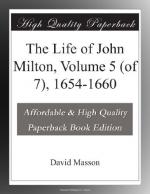In the nomination of a new Council of State the House adhered to the now orthodox number of thirty-one. Monk was named first of all, by special and open vote, on the 21st of February; and the others were chosen by ballot, confirmed by open vote in each case, on the 23rd, when the number of members present and giving in voting-papers was 114. The list, in the order of preference, was then, as follows:—
General GEORGE MONK
William Pierrepoint
John Crewe
Colonel Edward Rossiter (Rec.)
Richard Knightley
Colonel Alexander Popham
Colonel Herbert Morley
Lord Fairfax
Sir Anthony Ashley Cooper, Bart.
Sir Gilbert Gerrard, Bart.
Lord Chief Justice St. John
Lord Commissioner Widdrington
Sir John Evelyn of Wilts
Sir William Waller
Sir Richard Onslow
Sir William Lewis, Bart.
Colonel (Admiral) Edward Montague (Rec.)
Colonel Edward Harley (Sec.)
Richard Norton (Rec.)
Arthur Annesley (Rec.)
Denzil Holles
Sir John Temple (Rec.)
Colonel George Thompson (Sec.)
John Trevor (Rec.)
Sir John Holland, Bart.
Sir John Potts, Bart.
Colonel John Birch (Rec.)
Sir Harbottle Grimstone
John Swinfen (Rec.)
John Weaver (Rec.)
Serjeant John Maynard.
With the exception of Monk and Fairfax, who were not members of the Parliament, and the latter of whom was absent in Yorkshire, these Councillors are to be imagined as also active in the business of the House. About nine of them were Residuary Rumpers who had accepted willingly or cheerfully the return of the secluded. The proportion of Residuary Rumpers in the whole House was even larger. Though it had been reported by Prynne that as many as 194 of the secluded were still alive, and a contemporary printed list gives the names of 177 as available,[1] the present House never through its brief session attained to a higher attendance than 150, the average attendance ranging from 100 to 120; and I have ascertained by actual counting that more than a third of these were Residuary Rumpers. It is strange to find among them such of the extreme Republicans as Hasilrig, Scott, Marten, and Robinson. They left the House for a time, but re-appeared in it, whereas Ludlow and Neville and others would not re-appear—Ludlow, as he tells us, making a practice of walking up and down in Westminster Hall outside, partly in protest, partly to show that he had not fled.[2] Actually six Regicides remained in the House: viz. Scott, Marten, Ingoldsby, Millington, Colonel Hutchinson, and Sir John Bourchier. The majority of the Residuary Rumpers, however,—represented by such men as Lenthall, St. John, Ashley Cooper, Colonel Thompson, Colonel Fielder, Carew Raleigh, Attorney-General Reynolds, Solicitor-General Ellis, and Colonel Morley, and even by two of the Regicides mentioned (Ingoldsby and Hutchinson),—were




